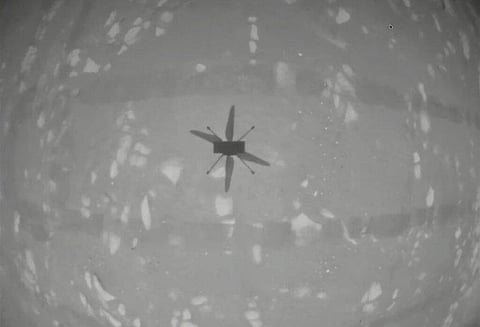

CAPE CANAVERAL: NASA’s experimental Mars helicopter rose from the dusty red surface into the planet's thin air on Monday, achieving the first powered flight on another planet.
The triumph was hailed as a Wright Brothers moment. The mini 4-pound (1.8-kilogram) copter named Ingenuity, in fact, carried a bit of wing fabric from the 1903 Wright Flyer, which made similar history at Kitty Hawk, North Carolina.
“Altimeter data confirms that Ingenuity has performed its first flight, the first flight of a powered aircraft on another planet,” said the helicopter’s chief pilot back on Earth, Havard Grip, his voice breaking as his teammates erupted in cheers.
Flight controllers in California confirmed Ingenuity’s brief hop after receiving data via the Perseverance rover, which stood watch more than 200 feet (65 meters) away. Ingenuity hitched a ride to Mars on Perseverance, clinging to the rover’s belly upon their arrival in an ancient river delta in February.
The $85 million helicopter demo was considered high risk, yet high reward.
“Each world gets only one first flight,” project manager MiMi Aung noted earlier this month. Speaking on a NASA webcast early Monday, she called it the “ultimate dream.”
Aung and her team had to wait more than three excruciating hours before learning whether the pre-programmed flight had succeeded 178 million miles (287 million kilometers) away. Adding to their anxiety: A software error prevented the helicopter from lifting off a week earlier and had engineers scrambling to come up with a fix.
Applause, cheers and laughter erupted in the operations center when success was finally declared. More followed when the first black and white photo from Ingenuity appeared on their screens, showing its shadow as it hovered above the surface of Mars. Next came the stunning color images of the helicopter descending back to the surface, taken by Perseverance, “the best host little Ingenuity could ever hope for,” Aung said in thanking everyone.
NASA had been aiming for a 40-second flight, and while details were initially sparse, the craft hit all its targets: spin-up, takeoff, hover, descent and landing.
ALSO WATCH:
To accomplish all that, the helicopter’s twin, counter-rotating rotor blades needed to spin at 2,500 revolutions per minute — five times faster than on Earth. With an atmosphere just 1 percent the thickness of Earth’s, engineers had to build a helicopter light enough — with blades spinning fast enough — to generate this otherworldy lift. At the same time, it had to be sturdy enough to withstand the Martian wind and extreme cold.
More than six years in the making, Ingenuity is a barebones 1.6 feet (0.5 meters) tall, a spindly four-legged chopper. Its fuselage, containing all the batteries, heaters and sensors, is the size of a tissue box. The carbon-fiber, foam-filled rotors are the biggest pieces: Each pair stretches 4 feet (1.2 meters) tip to tip.
The helicopter is topped with a solar panel for recharging the batteries, crucial for its survival during the minus-130 degree Fahrenheit (minus-90 degree-Celsius) Martian nights.
NASA chose a flat, relatively rock-free patch for Ingenuity’s airfield, measuring 33 feet by 33 feet (10 meters by 10 meters). It turned out to be less than 100 feet (30 meters) from the original landing site in Jezero Crater. The helicopter was released from the rover onto the airfield on April 3. Flight commands were sent Sunday, after controllers sent up a software correction for the rotor blade spin-up.
The little chopper with a giant job attracted attention from around the world, from the moment it launched with Perseverance last July until now. Even Arnold Schwarzenegger joined in the fun, rooting for Ingenuity over the weekend via Twitter. “Get to the chopper!” he shouted, re-enacting a line from his 1987 sci-fi film “Predator.”
Up to five helicopter flights are planned, each one increasingly ambitious. If successful, the demo could lead the way to a fleet of Martian drones in decades to come, providing aerial views, transporting packages and serving as scouts for astronauts. High-altitude helicopters here on Earth could also benefit — imagine choppers easily navigating the Himalayas.
Ingenuity’s team has until the beginning of May to complete the test flights. That’s because the rover needs to get on with its main mission: collecting rock samples that could hold evidence of past Martian life, for return to Earth a decade from now.
Until then, Perseverance will keep watch over Ingenuity. Flight engineers affectionately call them Percy and Ginny. “Big sister’s watching,” said Malin Space Science Systems’ Elsa Jensen, the rover’s lead camera operator.